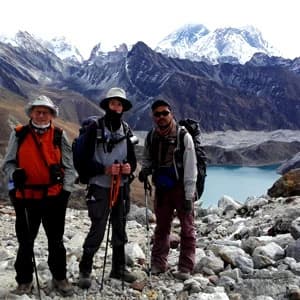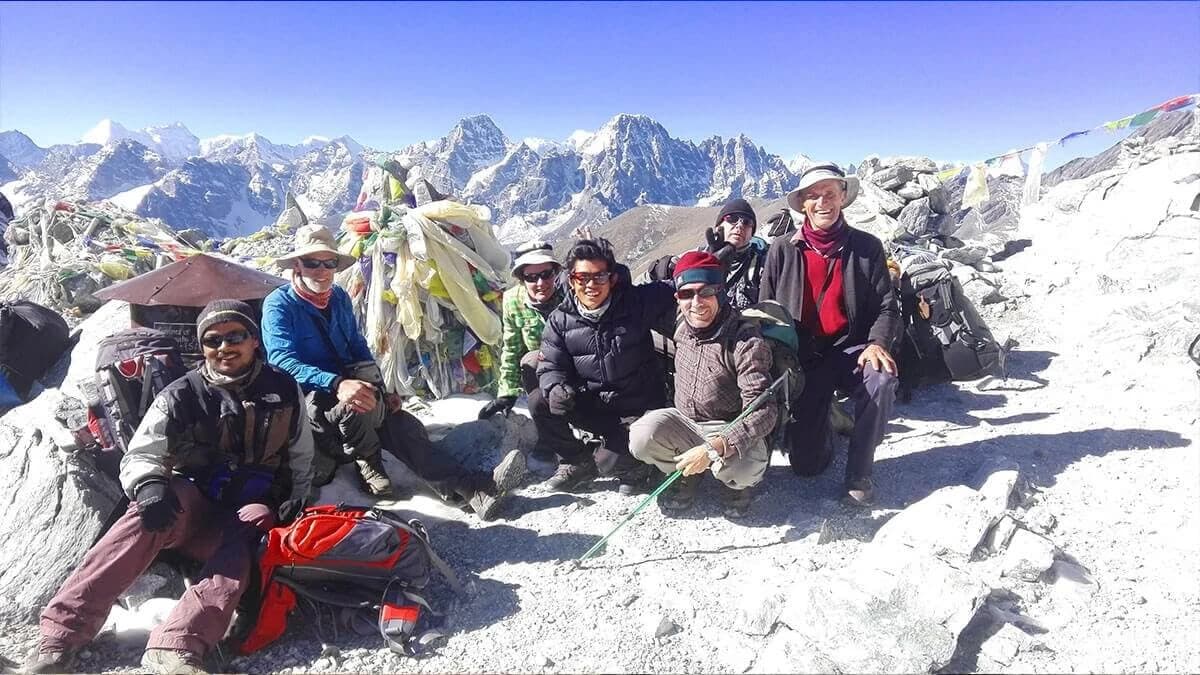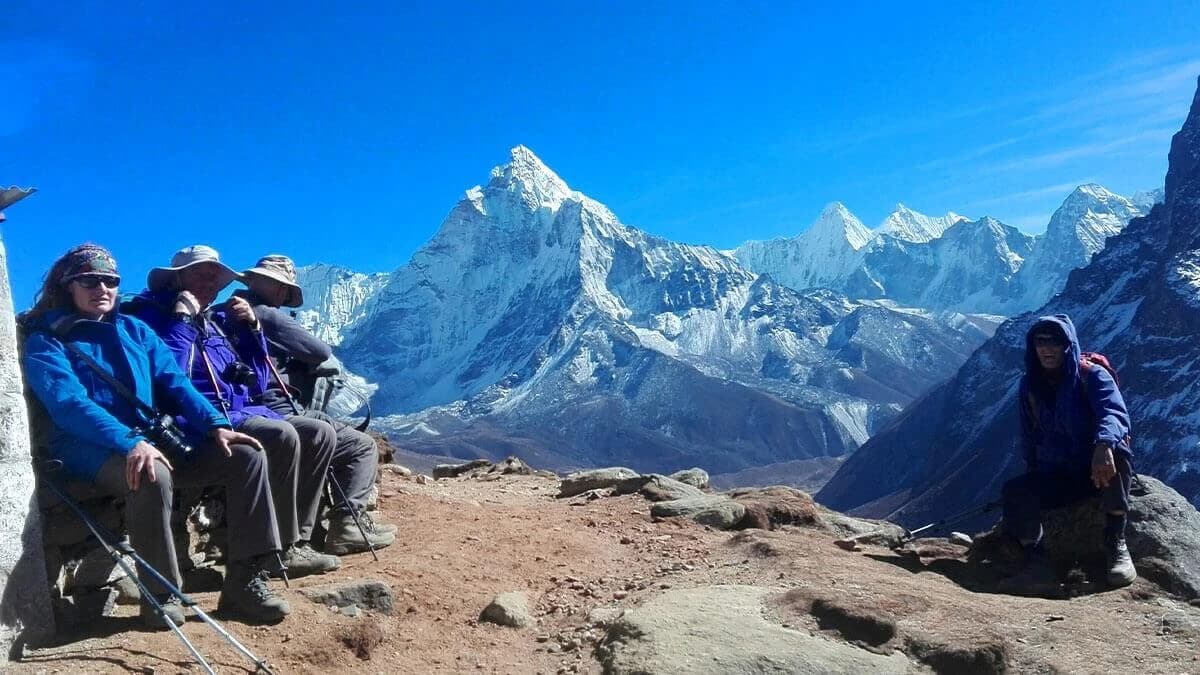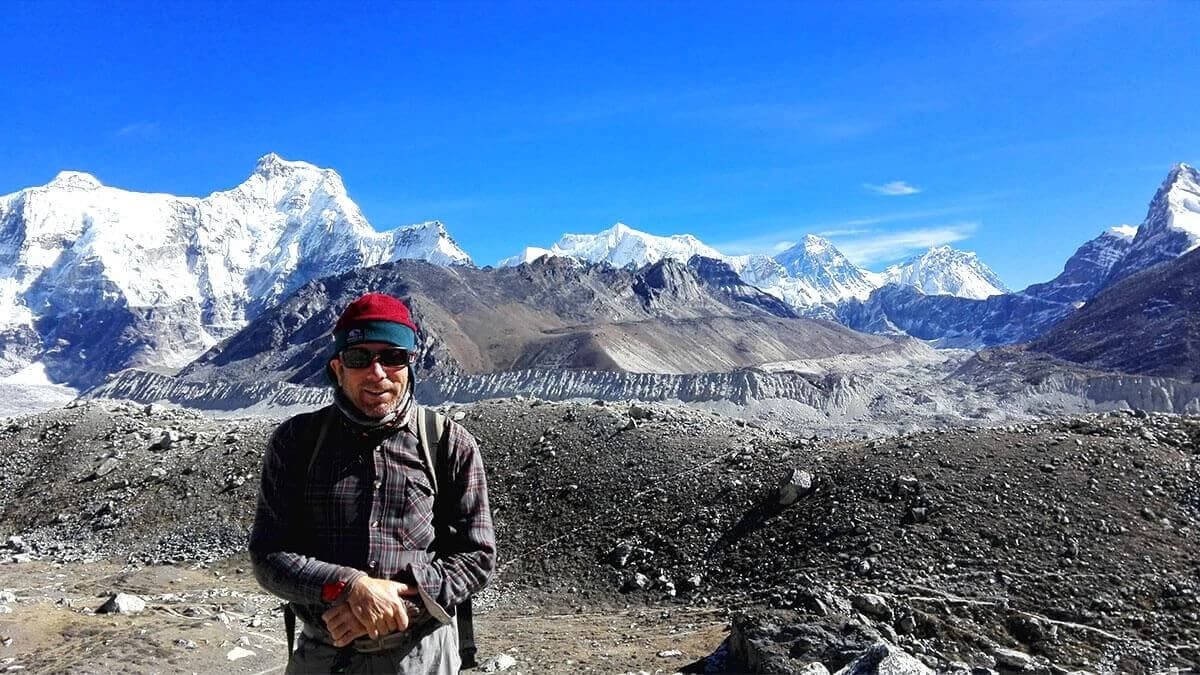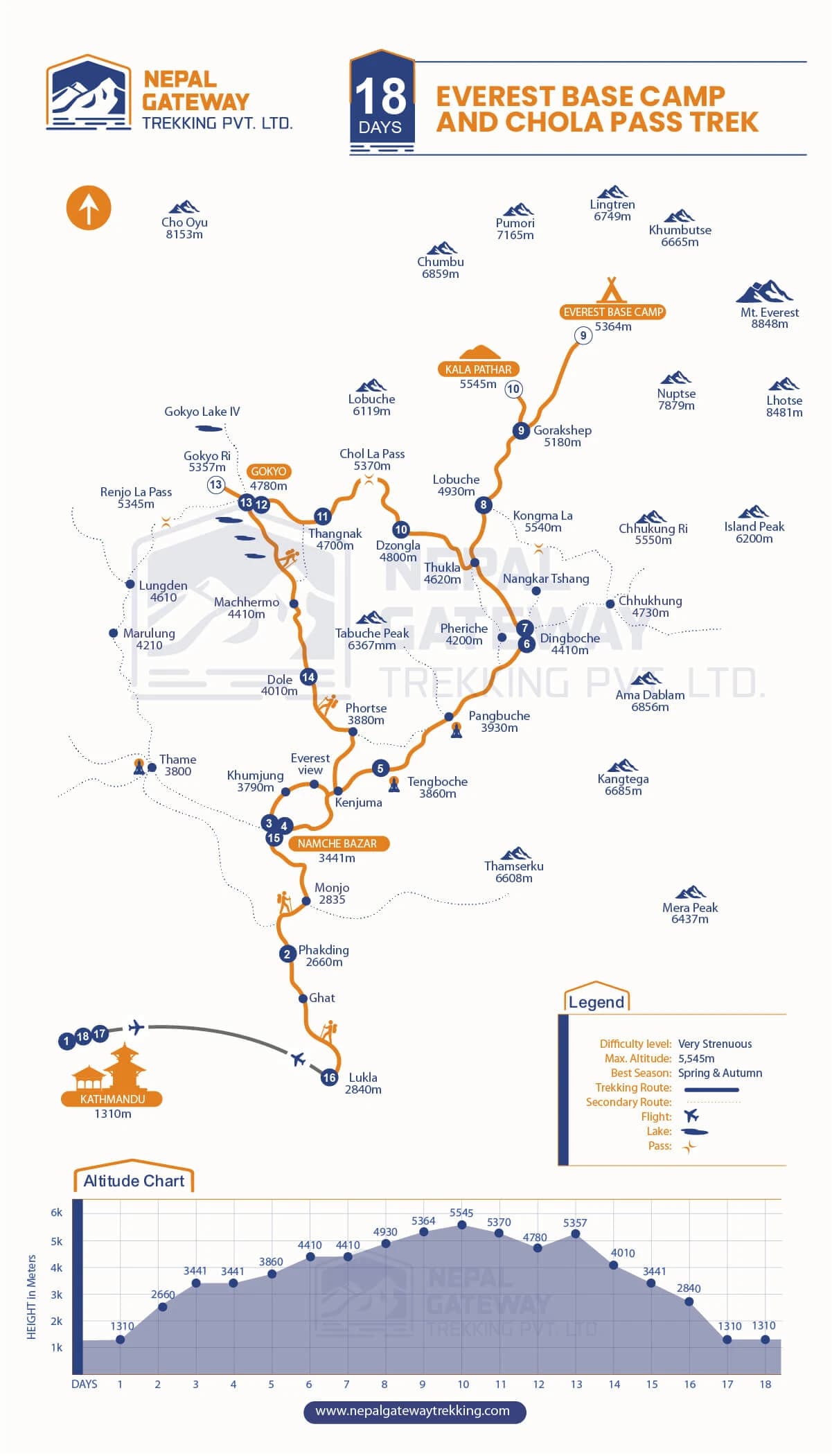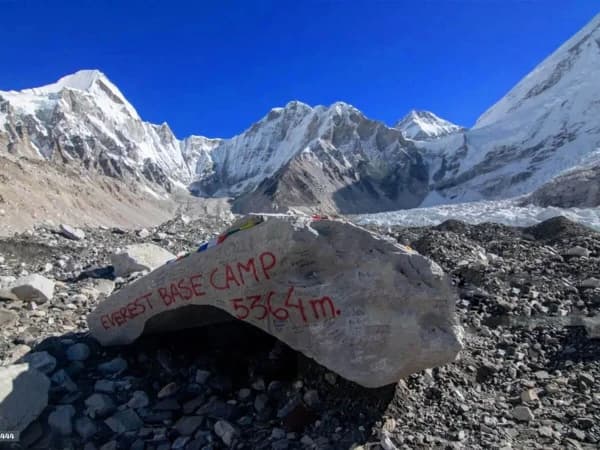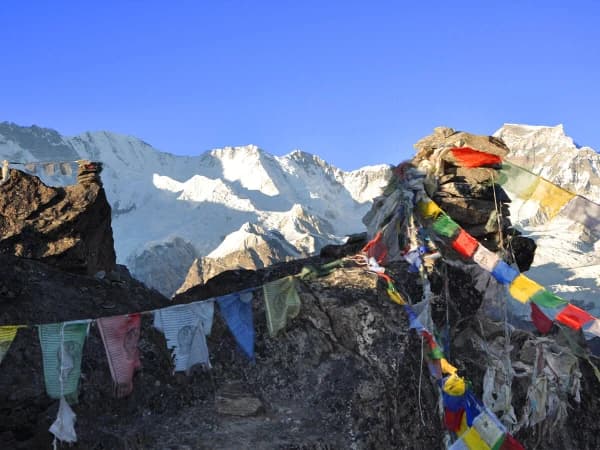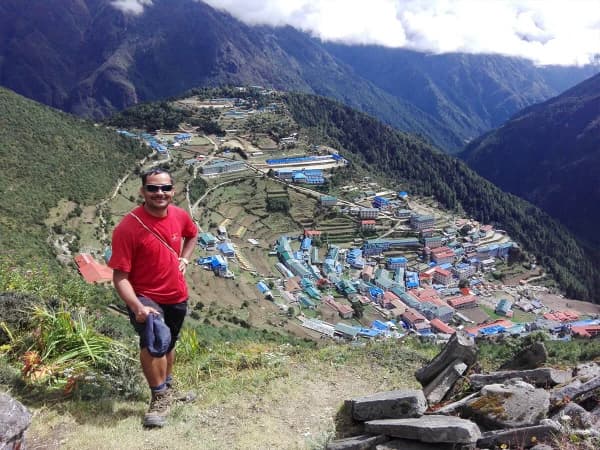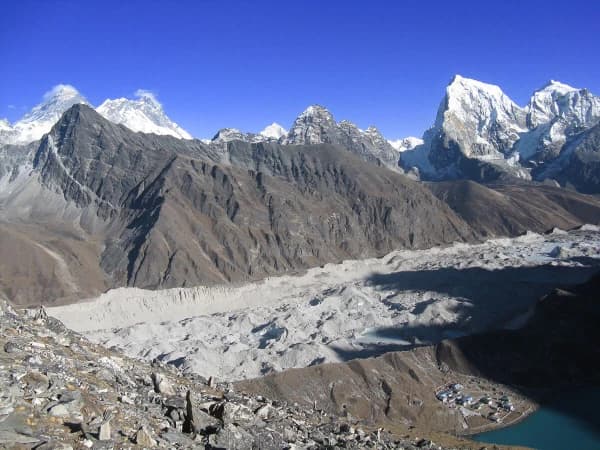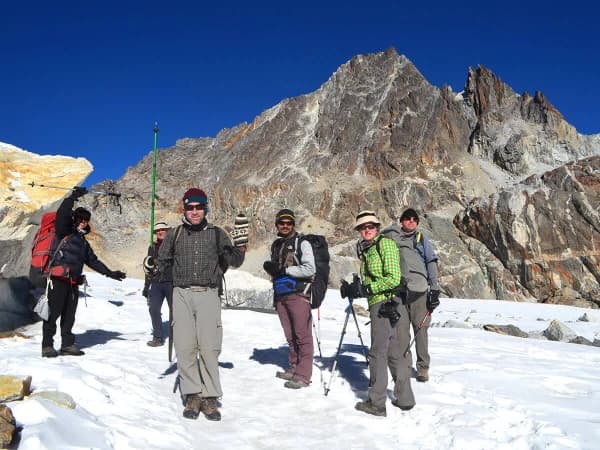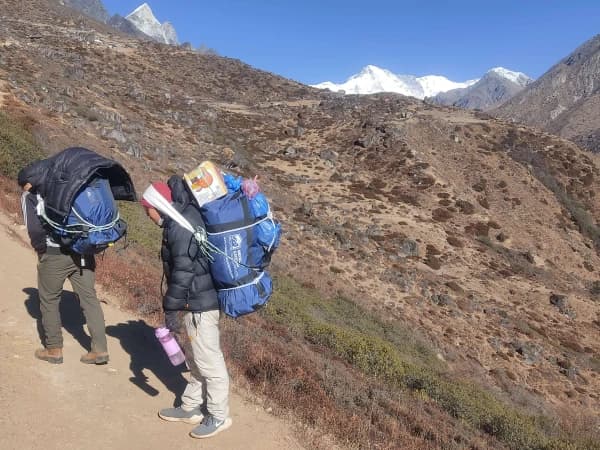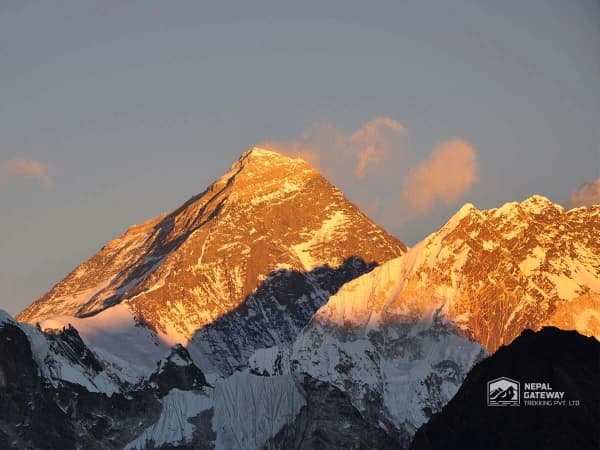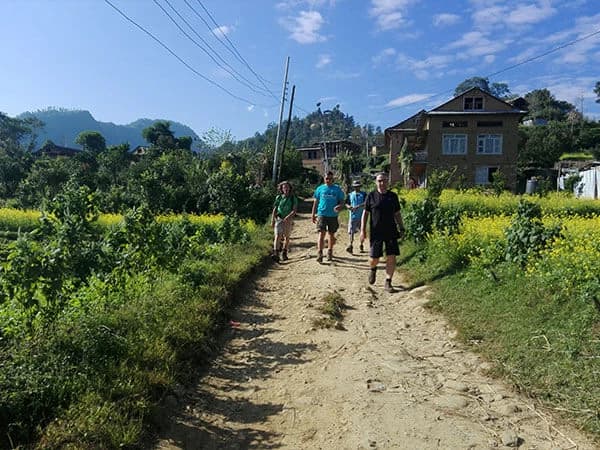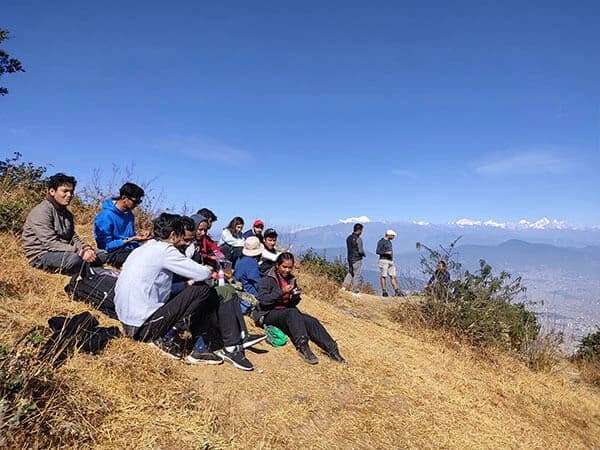Everest Base Camp and Chola Pass is one of the best trek extensions to the classic Everest Base Camp. It combines the traditional route of Everest with the unexplored wonders of the Gokyo Valley.
Everest Base Camp and Chola Pass Trek
Everest Base Camp and Chola Pass Trek, one of the most challenging treks in the Everest region, combines Everest Base Camp with turquoise Gokyo Lake. The 18-day itinerary takes you across some of Khumbu’s most iconic landmarks. On the same trek, you’ll visit the famous base camp of Mt. Everest and explore the tranquil Gokyo Lakes.
Besides that, this trek takes you to the summits of Kala Patthar and Gokyo Ri, which reward you with a fascinating view of Mt. Everest, Lhotse, Makalu, and Cho Oyu. Crossing the Cho La Pass at 5,420 meters is another highlight of this trek.
Besides its natural beauty, the Everest Base Camp Cho La Pass Trek combines culture and spirituality. It includes visiting the ancient Buddhist monasteries of Tengboche and Khumjung Valley, which will give you a deeper understanding of their culture and religion. Moreover, you’ll discover the rustic lifestyle of the Sherpa community and experience their royal hospitality.
Important Note: During the peak season, flights will be operated from Manthali Airport, Ramechhap, to Lukla. In the spring, from mid-March to mid-May and late September to November in autumn, all flights take off and land at Manthali Airport.
The Manthali airport, Ramechhap, is 142 km from Kathmandu, a 4-5 hour drive. To catch a flight to Lukla from Ramechhap, you must depart from Kathmandu from 1 a.m. to 2 a.m.
We highly recommend that you come with at least one more extra day for jet lag, especially considering the early morning drive to Manthali Airport, which benefits from adequate rest and sleep beforehand.
The Major Highlights of EBC Chola Pass Trek
- Feel the adrenaline rush while flying in and out of Tenzing-Hillary Airport in Lukla.
- Stand at the foothills of the world’s highest mountain—the mighty Mount Everest.
- Summit two of the best viewpoints in the Everest region—Kala Patthar and Gokyo Ri.
- Cross one of Nepal’s highest mountain passes—Cho La Pass at 5,420 meters.
- Stand at the shore of the pristine Gokyo Lakes and relish its serenity.
- Visit the ancient Buddhist monastery of Tengboche.
- Savour the majestic view of Khumbu Icefall and Khumbu Glacier.
- Walk across the largest glacier in the Himalayas—Ngozumpa Glacier.
- Opportunity to marvel at the rare sight of the world’s highest mountains, including Mt. Everest, Makalu, Lhotse, Cho Oyu, Ama Dablam, and Thamserku.
EBC Chola Pass Route Overview
The Everest Base Camp Cho La Pass Trek begins with an electrifying flight to Tenzing-Hillary Airport in Lukla. Trudging past the famous Sherpa settlements like Namche Bazaar, Tengboche, Dingboche, and Lobuche, you’ll make your way to the foothills of the mighty Everest.
The next morning, you’ll hike to the top of Kala Patthar, which offers a glorious sunrise view glistening over the Himalayan panorama. At 5,545 meters, Kala Patthar marks the highest elevation point of the Everest Base Camp Cho La Pass Trek.
After that, you’ll retrace the route to Lobuche and head towards Dzongla. You’ll continue the trek by crossing the Cho La Pass at 5,420 meters and settling in at Dragnag. You’ll cross the Himalayas’ largest glacier—Ngozumpa Glacier—and reach the Gokyo Valley.
The following morning, you’ll climb another viewpoint of Gokyo Ri and relish the captivating view of the mountains and the lakes. Finally, head back to Lukla via Dole and Namche Bazaar to catch a flight to Kathmandu and conclude the trek.
The Everest Base Camp Cho La Pass Trek is a lifetime experience that blends the Khumbu region's natural, cultural, and spiritual elements.
Why Everest Base Camp Cho La Pass Trekking with Nepal Gateway Trekking?
- Our trekking guides and local crew are experts with over a decade of experience leading treks in the Himalayas. They will help you navigate this remote trail and share valuable insights about the region’s culture, history, and lifestyle.
- Comprehensive safety measures, including a well-paced itinerary, acclimatization strategies, a wilderness first-aid kit, and emergency protocols.
- We will handle the overall logistics of the trek, including trekking permits, flight tickets, road transportation, accommodation, meals, etc., to ensure a hassle-free experience.
- We follow sustainable practices and minimize waste to ensure our treks positively impact the environment and the local community.
- We provide a 3-star category hotel (Woodapple Hotel and Spa) in Kathmandu to ensure comfort and luxury. Likewise, we handpick the finest teahouses in the region and provide all meals during the trek.
- We provide a Nepal Gateway Trekking t-shirt and duffel bag as a souvenir.
Itinerary
This is our standard and recommended Everest Base Camp and Chola Pass Trek itinerary.
The representative of Nepal Gateway Trekking will greet you at the Tribhuvan International Airport and transfer you to Woodapple Hotel and Spa (or similar) in Thamel. After checking in, you’ll have a free day to recover from jet lag or stroll around Thamel for last-minute shopping.
Your trekking guide will arrive at the hotel lobby for an informal briefing session in the evening. After the session, he’ll quickly examine your gear and supplies to ensure you’ve packed all the essentials.
Note: Please pack your bags for the trek before sleeping. You’ll leave early to catch the Lukla flight the following day.
Drive to the domestic terminal of TIA in Kathmandu to catch a flight to Lukla. Flying to Lukla is an other-worldly experience. The short 40-minute flight offers a scenic view of the surrounding mountains and landscapes.
Upon landing at Tenzing-Hillary Airport in Lukla, you’ll meet the team of sherpas and porters who’ll accompany you on this trek. Then, we set off on a gradual walk to Phakding to settle for the night. This is a short and relaxing day, perfect to warm you up for the rest of the trek.
Important Note: During the peak season, flights will be operated from Manthali Airport, Ramechhap, to Lukla. In the spring, from mid-March to mid-May and late September to November in the autumn season, all flights take off and land at Manthali Airport.
The Manthali airport, Ramechhap, is 142 km from Kathmandu, a 4-5 hour drive. To catch a flight to Lukla from Ramechhap, you must depart around 1 a.m. to 2 a.m. from Kathmandu.
Start the day with a mountain-style breakfast and gear up for the trail. The first half of the day is a gradual walk on the riverbank of the Dudh Koshi River. After a few hours, you’ll arrive at the Sagarmatha National Park entrance gate in Monjo. You must submit your permit details to the official for quick verification.
After the permit check, head downwards through the trail surrounded by the large mani walls on the way to Jorsalle for the lunch break. After lunch, you’ll cross several steel suspension bridges over the Dudh Koshi River. The final section of the day is a steep two and a half-hour climb to the Sherpa Capital of Khumbu—Namche Bazaar.
On the halfway point of this steep hill, you’ll get a first distant view of Mt. Everest.
Your first acclimatization day of the Everest Base Camp Cho La Pass Trek. On this day, you’ll hike to the green valleys of Khunde and Khumjung to help your body acclimatize before heading to the higher elevation.
It takes around two hours to reach Khunde from Namche Bazaar. Here, you’ll visit Khunde Gompa and Khunde Hospital. Later, you descend through a cobbled path to Khumjung. You’ll explore the village before visiting Khumjung Monastery and Khumjung Secondary School.
When you’re ready, return to Namche Bazaar via Everest View Hotel. From the balcony of this luxury hotel, you can savour the panoramic view of the mountains, including Thamserku, Ama Dablam, Nuptse, and Mt. Everest.
Depending on your condition, you can also visit the Sherpa Culture Museum and the Sagarmatha National Park Visitor Centre on your way back to Namche Bazaar.
After a pleasant day at Namche Bazaar, you’ll continue the trek towards Tengboche. Rhododendrons and pine trees surround the trail and offer a marvellous view of the Himalayas.
After a few hours, you head downhill towards Imja Khola and stop at Phunki Tenga for lunch. After lunch, the pleasant trail turns into a steep two-hour climb until you reach Tengboche.
Tengboche is a significant cultural centre of the Everest region. It is home to Khumbu’s largest Buddhist monastery, which you can visit in the evening. This small settlement offers a close-up view of Ama Dablam, Lhotse, and Mt. Everest.
After breakfast, you’ll begin the day walking northwards from Tengboche. You’ll descend the forested trails of Debuche, cross a small suspension bridge over the Imja Khola, and gradually climb to Pangboche. Enjoy the opportunity to get a close-up view of Ama Dablam.
The rest of the day will be difficult as the landscape makes way for a narrow, deserted trail towards Worsho. From here, you’ll follow the lower route to the riverbank and continue the walk until you arrive at Dingboche.
Note: On this day, you’ll spend your first night over 4,000 meters. Dingboche is often considered the wall where most trekkers start to feel the effects of high altitude. To reduce the risk of high-altitude sickness, we recommend staying hydrated and keeping your body warm.
A much-needed acclimatization day before heading to higher elevation. On this day, you’ll hike to the summit of Nangkartshang Peak to keep up the momentum.
It takes approximately 3 hours to scale the summit of Nangkartshang Peak from the village. At 5,083 meters, this summit offers a breathtaking view of Ama Dablam, Makalu, Kantega, and Cho Oyu. Moreover, you can also catch a glimpse of Chukung Ri, Nuptse Glacier, and Imja Tse from the top.
After relishing the marvellous scenery, you’ll retrace your route to Dingboche and get some rest.
The trek will become more challenging from here due to the high altitude and rough terrain. The day begins with a gentle climb over the ridge above Dingboche. The trail is bare and rugged, covered only with alpine scrubs, with Taboche and Cholatse towering westwards.
Upon reaching Dughla, you’ll take a short break to catch some breath. Later, climb a massive stony moraine of the Khumbu Glacier towards the Everest Memorial on the summit of Dughla Pass. Here, you’ll find the stone memorial shrines dedicated to the fallen mountaineers who perished while summiting Mt. Everest.
From here, the trail suddenly turns gradual and less exhausting until you arrive at Lobuche for an overnight stay. This teahouse settlement is in a small meadow between Lobuche Peak and Khumbu Glacier.
This is it! Your big day begins with a gradual walk through a small valley directly beside the Khumbu Glacier. The route gradually becomes more demanding as you ascend across the rubble of a tributary glacier. Here, you’ll approach the massive Khumbu Glacier stretching down the valley towards the base camp.
After a few hours of challenging hikes on rocky trails and moraine, you'll arrive at Gorak Shep. Here, you'll drop your backpacks and take a short break at the teahouse before you continue the rest of the hike to the Everest Base Camp.
From here, you’ll continue the walk on a steady trail over the glacial moraine towards the base camp. You’ll spend an hour or so at the foothills of the world’s highest mountain, enjoying the marvellous sight of the Khumbu Glacier, Khumbu Icefall, Nuptse, Khumbutse, Pumori, and a little bit of Mt. Everest.
Later, return to the teahouse at Gorak Shep to settle for the night.
You’ll begin the hike before dawn towards the viewpoint of Kala Patthar. Although short in distance, the 2-hour hike to the top is steep, rocky, and strenuous.
Nestled at 5,545 meters, Kala Patthar is the highest elevation point of the Everest Base Camp Cho La Pass Trek. The summit rewards you with the 360-degree panorama of Pumori, Nuptse, Mt. Everest, Lhotse, Changtse, and many other mountains. Besides that, this viewpoint offers the finest sunrise view over the Himalayas.
After spending a while at Kala Patthar, you’ll return to Gorak Shep for breakfast. You’ll retrace the steps back to Lobuche after breakfast. Further down, before you approach the Everest Memorial, you’ll take a different route alongside Cho La Lake towards Dzongla.
This could perhaps be the most challenging day of the Everest Base Camp Cho La Pass Trek. On this day, you’ll wake up early, around 4 AM, to cross the Cho La Pass. Initially, the route is gradual and more defined on a grazing pasture beneath the massive Cholatse.
Once you approach the pass, the first section involves crossing the Cho La Glacier, often covered in snow. Hence, having microspikes or crampons can come in handy to cross this section. The route slowly becomes steep and strenuous towards the top, involving walking over boulders and loose scree.
The strenuous climb to the top offers an incredible view of the surrounding landscapes and mountain peaks.
The descent involves a massive drop over a large boulder field. You’ll conclude this strenuous day at the remote settlement of Dragnag.
The walk from Dragnag to Gokyo Valley is relatively short and easy. The day begins with a gradual walk across the valley towards the moraine of Ngozumpa Glacier. The route across the glacier continually changes from season to season. Crossing this section can take anywhere from 90 to 120 minutes, depending on the route.
After crossing the glacier, you descend towards the second lake of Gokyo through the moraine. From here, the third lake of Gokyo is only a few minutes away. Walking by the side of this pristine lake, admiring its iridescent turquoise waters, you’ll reach the Gokyo Valley.
You'll have a free afternoon since you’ll arrive at the Gokyo Valley by lunchtime. You can either relax at the shore of the Gokyo Lake or hike up the valley to the fourth lake.
On this day, you’ll hike to the summit of the second viewpoint of this trek—Gokyo Ri at 5,357 meters. Like Kala Patthar, you’ll leave the teahouse before dawn and climb the steep hill northwest of the valley. So, keep your headlamps and torchlights to bear!
Reaching the summit of Gokyo Ri takes two hours of challenging ascent on a steep, rugged path. Although it is farther away, many argue that this viewpoint offers the best view of Mt. Everest (even better than Kala Patthar).
Enjoy the picture-perfect view of Mt. Everest, Makalu, Cho Oyu, Lhotse, and Gokyo Lakes. Later, you’ll retrace your steps back to Gokyo Valley. Take some much-needed rest and relax at the shore of pristine Gokyo Lake.
After breakfast, you’ll follow the trail alongside the Gokyo Lake towards the moraine of Ngozumpa Glacier. You’ll walk past the second and first lakes of Gokyo to arrive at the village of Pangka.
From here, the trail gradually descends over a scenic ridge towards Machhermo. You’ll continue the walk with a gentle descent, passing Luza Kharka and Lapharma Kharka towards Dole.
On this day, you’ll return to the famous town of Namche Bazaar. You’ll start the day descending steadily through several remote villages, including Phortse Tenga and Mong. From Mong La, the trail drops rapidly towards the crossroad settlement of Kyangjuma.
This intersection separates four routes: Khumjung, Namche Bazaar, Dole, and Tengboche. From here, you take a path to Namche Bazaar and return to the town for an overnight stay.
After breakfast, you’ll begin the final day in the mountains with a steep, challenging descent towards Jorsalle. From here, the trail becomes relatively slow and easy on the riverbank of the Dudh Koshi River.
The journey's final stretch involves a steady climb until you arrive at the small town of Lukla. Here, you’ll conclude the Everest Base Camp Cho La Pass Trek with a farewell party in the evening. You’ll celebrate your accomplishment with your trekking crew.
On this day, you’ll catch an early morning flight from Lukla to Kathmandu, bidding the mountains goodbye. Upon landing, Nepal Gateway Trekking’s representative will transfer you to the Woodapple Hotel and Spa (or similar) in Thamel.
You’ll have a free afternoon to get some rest and reflect on your days in the Himalayas. You can also stroll around the busy streets of Thamel and buy souvenirs.
Pack your bags and stay ready; today marks your final day in Nepal.
We’ll arrange a drop-off at Tribhuvan International Airport depending on your flight time. The pickup time will be scheduled three and a half hours before departure.
Hope you have a great flight! See you soon.
Dates & Availability
Private tripCost Includes
- All ground transportation as per itinerary.
- Two nights’ accommodation at a three-star category hotel in Kathmandu, inclusive of breakfast.
- Round-trip flight ticket (Kathmandu/Lukla/Kathmandu or Ramechhap/Lukla/Ramechhap) inclusive of domestic airport taxes.
- Three meals (breakfast, lunch, and dinner) during the trekking.
- Twin-sharing common room during the trekking.
- One highly experienced English-speaking & friendly trekking guide and required porter, including their expenses.
- Sagarmatha National Park permit and TIMS card.
- Everest Base Camp Chola Pass Trekking Map.
- Nepal Gateway Company T-shirt.
- Nepal Gateway Company duffle bags for trekking.
- Local fresh fruits (apples, oranges, pomegranates, bananas, etc.).
- First aid kit with oximeter.
- Evacuation assistance.
- Government taxes.
- Office service charge.
Cost Excludes
- Lunches and dinners in Kathmandu.
- Your travel insurance (compulsory).
- Nepal entry visa.
- Your international flight ticket to/from Kathmandu.
- Your personal nature expenses, equipment, and medical kit.
- All kinds of hot drinks (tea/coffee/hot water).
- Cold drinks (mineral water/coke/Fanta) during the trek.
- Alcoholic beverages on trekking.
- Hot shower, internet, and phone call unless it is free.
- Tipping to field staff (tipping is not mandatory but expected).
Good To Know
What is the cost for Everest Base Camp Cho La Pass Trek Route?
The cost of Everest Base Camp Cho La Pass Trek Route can differ depending on various factors, such as the quality of accommodation, type of services, mode of transportation, and duration of the trek.
Typically, the price of the Everest Base Camp Cho La Pass Trek for a single person is USD 1610. The 18-day package includes all the essentials, such as accommodation, meals, domestic airfares, entrance permits, guide and porter costs, etc.
If you have a large group, Nepal Gateway Trekking offers a special discount of USD 80 to USD 150 on the standard price, depending on the group size. Note that the rooms and services in this price range are relatively basic.
However, you can upgrade the Everest Base Camp Cho La Pass Trekking package from standard to luxury. In this option, you will stay in high-end mountain lodges with electric blankets, ensuite bathrooms, hot showers, high-speed internet connections, and in-room charging facilities.
Furthermore, you can upgrade your regular flight to a helicopter option from Kathmandu to Lukla. It is a more comfortable, time-saving, and reliable way to reach Lukla. However, a group helicopter flight can cost you around USD 600 per person, while a chartered flight can cost you up to USD 3,000.
Detailed Information on Lukla’s Flight
Flying to Lukla is the most popular way for travellers to reach the high valleys of the Everest region. Nestled on a cliffside at 2,860 meters, this small airstrip is often considered the most dangerous in the world. Its asphalt runway is only 527 meters long and 20 meters wide.
Regardless, Lukla’s tiny airstrip is one of the busiest in the country, operating over 40 flights per day during the peak season. If you’re planning your next trip to the Everest region, here are a few ways to get to Lukla.
Kathmandu to Lukla Flight
Considering accessibility and overall logistics, a direct flight from Kathmandu is the most convenient way to reach Lukla. The 40-minute flight offers spectacular views of the Himalayas and the challenging terrain ahead.
However, this route has two significant challenges, which cause frequent delays and cancellations: the weather and the air traffic.
Since the weather in Lukla changes rapidly, having a consistent flight schedule is almost impossible. Although the weather stays clear in the mornings, it is not always guaranteed.
Besides that, air traffic congestion in the Kathmandu Airport disrupts the Lukla flights. Even when the weather is good in the mountains, the flights are often delayed due to high traffic.
Hence, direct flights between Kathmandu and Lukla only operate during the off-seasons, i.e., December to February and June to August. For the rest of the year, it is handled from Manthali Airport.
Manthali to Lukla Flight
The flight from Manthali Airport, Ramechhap, is a short and more reliable alternative to reaching Lukla. In September 2019, the Civil Aviation Authority of Nepal (CAAN) rerouted all Lukla flights from Kathmandu to Manthali.
The rerouting was intended to reduce delays, avoid cancellations, improve safety, and ensure a smooth travel experience. During peak seasons, Manthali is the only airport that operates commercial flights to and from Lukla.
To reach Manthali Airport, drive 130 kilometres from Kathmandu, which takes around five hours. Although getting there is not as convenient as flying directly from Kathmandu, it is a more reliable alternative.
This is because Lukla and Manthali Airport distance is significantly closer than Kathmandu, taking only 12 to 15 minutes. More flights can take place from Mathali Airport on a clear day than from Kathmandu.
If you plan to do the Everest Base Camp Cho La Pass Trek in peak seasons, we will arrange private transportation to transfer you from Kathmandu to Manthali. You have two options — add an extra day to stay overnight at Manthali or wake up at 2 AM, drive to Manthali, and catch a flight to Lukla the same day.
Helicopter Option
If driving five hours to catch a flight to Lukla sounds like a nightmare, booking a helicopter is the best alternative. Unlike commercial flights, helicopters are more reliable, comfortable, and safe. It is because poor visibility and bad weather do not necessarily prevent them.
The helicopter option will undoubtedly be more expensive than the regular flights. The group package will cost around USD 600 per person (a maximum of five pax), while the chartered option will cost anywhere between USD 2500 and 3000.
If you choose the helicopter option, please inform us before you arrive in Nepal so we can make the necessary arrangements with the helicopter company.
Flight Delays and Cancellations
Flights to Lukla are prone to delays and cancellations due to several factors, including:
Weather
The most common factor that causes delays or cancellations to Lukla flights is weather conditions. Although the mornings are usually clear, the weather changes significantly, causing low visibility, thick cloud covers, and strong winds.
Season
If you’re flying to Lukla in the monsoon or winter, flight delays and cancellations are likely higher than in other seasons. These seasons invite thick rain clouds, dense fog, and strong winds.
Air Traffic Congestion
During peak trekking seasons, flights to Lukla are prone to delays and cancellations due to congestion at Tribhuvan International Airport in Kathmandu. Commercial flights to and from Lukla operate from Manthali Airport in these seasons to prevent this.
Delays and cancellations in Lukla are unavoidable. Therefore, adding at least one buffer day to your itinerary is advisable to deal with the inconvenience.
Everest Base Camp and Cho La Pass Trek Permit
You’ll require two mandatory permits for Everest Base Camp and Cho La Pass Trek.
1. Khumbu Pasang Lhamu Rural Municipality Permit
The first permit you must acquire for the Everest Base Camp Cho La Pass Trek is the Khumbu Pasang Lhamu Rural Municipality Permit, shortly known as the Khumbu Trekking Permit. This newly introduced permit is only applicable in the Khumbu region. It was introduced in October 2018 by the local government of the Khumbu region, replacing the TIMS Card.
Where can you get the Khumbu Pasang Lhamu Rural Municipality Permit?
Ans - You can obtain the Khumbu Pasang Lhamu Rural Municipality Permit at the checkpoint in Lukla (Khumbu Pasang Lhamu Rural Municipality Office) or the national park entrance checkpoint in Monjo.
The permit cost is NPR 3,000 for all international trekkers.
2. Sagarmatha National Park Permit
The Sagarmatha National Park Permit is another permit you must acquire for the Everest Base Camp Cho La Pass Trek. This is a mandatory permit, as you’ll spend most of the days of your trek within the Sagarmatha National Park, a protected area in the Himalayas of northeast Nepal.
Where can you get the Sagarmatha National Park Permit?
Ans—You can get this permit at the permit checkpoint in Lukla or the national park entrance gate in Monjo. You can also obtain the Sagarmatha National Park Permit at the Nepal Tourism Board office in Kathmandu.
The permit cost is NPR 3,000 for foreigners and NPR 1,500 for SAARC Nationals.
Everest Base Camp and Chola Pass Trek Difficulty
Everest Base Camp and Chola Pass Trek is a strenuous, high-altitude trek in the remote part of the Himalayas. During this trek, you’ll have to walk up to 6 to 7 hours daily in rough terrains, adverse weather conditions, and high altitudes.
Out of the 15 nights in the mountains, you’ll spend nine successive ones over the elevation of 4,000 meters. In such elevation, oxygen and air pressure levels drop significantly, increasing the risk of high-altitude sickness.
In addition, the Everest Base Camp Cho La Pass Trek will take you to the summits of two viewpoints above 5,000 meters: Gokyo Ri (5,357 meters) and Kala Patthar (5,545 meters). Apart from the elevation, climbing the steep, rough trails to these viewpoints can test your physical and mental endurance.
Likewise, you’ll have to cross one of Nepal’s highest mountain passes — Cho La Pass. At 5,420 meters, this high pass's steep, icy paths demand an excellent level of fitness and experience. This is often considered the most challenging section of Everest Base Camp Cho La Pass Trekking.
If you plan this trek in the winter or monsoon season, you will have extra setbacks. Unlike the regular seasons, the weather might get extreme with excessive snowfall and rainfall. Most trails in the upper reaches of this trek may be covered in thick snow. Hence, you have to be extra cautious when trekking during these seasons.
Our slow-paced 18-day itinerary is rigorously designed with these challenges in mind. Therefore, it includes proper acclimatization days, well-calculated elevation gains, and decent walking distance to help you acclimate and adapt to challenging situations.
Training for Everest Base Camp Cho La Pass Trekking
Everest Base Camp Cho La Pass is one of the most challenging treks in Nepal. This trek will take you up to the world’s highest mountain base camp, scale two 5000+ meters viewpoints, and cross a high-altitude mountain pass. Hence, it demands careful preparation, mental resilience, strength, and stamina.
The level and intensity of training depend on your fitness level. Cardio workouts, strength training, stretching, and hiking can improve your fitness and make the trek more comfortable and enjoyable.
Once you sign up for the trek, start your fitness program at least 8 to 12 weeks before heading to the Himalayas. Remember, your fitness training should start slow and level up gradually as you improve. Please do not go overboard from the start, as it may result in excessive fatigue, muscle cramps, or long-term injuries.
Conditioning Hikes
Let’s start with the fundamentals! The best way to prepare for the EBC Cho La Pass Trek is to simulate what you’ll do on the trek. Try finding a few decent hiking spots near your hometown and starting to hike at least once a week.
Remember, progression is the key! Just because you should simulate does not mean you start with a 15 or 20-kilometer hike, wearing brand-new hiking boots and carrying a fully loaded backpack.
Always start slow. Start with a short 3—to 5-kilometer hike with a barely loaded backpack. Gradually increase the distance, intensity, altitude, and backpack weight each week.
If there aren’t any decent hiking trails nearby, you can climb up and down the stairs with a weighted backpack every other day, mixing it up with cardio, strength, and stretching workouts.
Conditioning is about how much you train and rest and how much you let your body recover. Balance exercise and recovery for better results.
Cardio Training
You will spend most days in the Everest Base Camp Cho La Pass Trek, walking up and down the rugged terrains with a weighted backpack. Moreover, a few sections will demand you to climb steep uphills at high altitudes.
Hence, you must condition your cardiovascular system to help your body work more effectively with less oxygen.
This does not necessarily mean you should get on a treadmill and run for hours every day. Instead, mix steady-state cardio workouts for about 45 to 60 minutes at least three to four days a week.
Recommended Cardio Exercises
- Slow-paced Running
- Brisk Walking or Jogging
- Swimming
- Mountain Biking
- Rowing Workouts
- Jump Roping
Stretching Workouts
Stretching workouts can be very beneficial for hikers and trekkers. Although often neglected over strength or cardio training, these exercises effectively provide your body with a wide range of flexibility and joint mobility.
Besides that, stretching helps improve blood circulation to reduce and recover from aching and sore muscles after the trek. Once you book your holiday, consider adding at least 15 to 20 minutes of daily stretching to your fitness training.
Recommended Stretching Exercises Before Trekking
- Shoulder Rolls
- Wrist Stretch
- Standing Quad Stretch
- Hamstring Stretch
- Calf Stretch
Recommended Stretching Exercises After Trekking
- Rag Doll Pose
- Ankle Stretch
- Standing Saddle Stretch
- Runner’s Lunge
Strength Training
Strength training can help build core and leg muscles, enhance balance and stability, and lower the possibility of injuries. Although you do not have to lift like a bodybuilder, a few strength training sessions can make your trek much more comfortable.
We recommend adding at least two to three days of strength training every week.
Recommended Strength Exercises
- Jump Squats - 15 to 20 repetitions
- Kettlebell Deadlifts - 5 to 6 repetitions
- Glute Bridge & Hamstring Curl - 10 to 15 repetitions
- Stairmaster for 20 minutes
- Step-Ups - 15 to 20 repetitions on each leg
- Downhill Lunges - 15 to 20 repetitions on each leg
- Side Plank with Leg Raise - 10 to 15 repetitions on each side
Best Time for Everest Base Camp Cho La Pass Trekking
Autumn (September to November)
Autumn is hands down the best time for the EBC Cho La Pass Trek. After the monsoon rain, the weather stays warm and dry most days, perfect for crossing a high mountain pass. Besides that, you’ll relish spectacular mountain views, especially from the top of Gokyo Ri and Kala Patthar.
However, the Everest region has the highest number of visitors in the autumn season. So, the trails and teahouses will likely be crowded with thousands of trekkers.
Spring (March to May)
The spring season usually brings warm mornings and extended daylight. Mornings are the best time to enjoy the mountain views. However, afternoons are generally covered with thick clouds.
Although spring is a good Everest Base Camp Cho La Pass Trek season, be aware of sudden weather shifts. If the conditions are unfavourable, do not attempt the Cho La Pass.
Besides the mountain scenery, spring is the best time to enjoy the blooming flowers, including rhododendrons and primroses. However, the trails will be busy, and the dining will be noisy during this time of the year.
Winter (December to February)
Although winters are not the most favourable time for the EBC Cho La Pass Trek, it is still doable. As expected, this season brings cold, frequent snowfall, and snow-covered trails.
The morning and evening are likely to be terribly cold, while the midday temperature is tolerable. During the winter season, the risk of high-altitude sickness, snow blindness, hypothermia, sunburn, and physical injuries is significant.
So, prepare and pack your gear appropriately! Remember to pack crampons and leg gaiters to cross Cho La Pass.
If you plan and prepare well, trekking in winter can be rewarding, with quiet and empty trails. Moreover, the views from Gokyo Ri and Kala Patthar will be other-worldly. The Gokyo Lakes will also remain frozen entirely during this time of the year.
Monsoon (June to August)
We do not recommend doing this trek in the monsoon season. It brings constant rainfall, bad visibility, and slippery slopes. Mornings are usually bright and clear, but the weather changes dramatically by early afternoon.
While it is possible to do the Everest Base Camp Cho La Pass Trek in the monsoon, the experience will not be as pleasant.
Acclimatization and Safety
Everest Base Camp Cho La Pass Trek involves multi-day walking in the high Himalayas of Nepal. In this trek, you’ll spend nine nights over 4,000 meters, crossing one of the highest mountain passes — Cho La Pass at 5,420 meters.
Besides that, you’ll climb two of Khumbu’s highest viewpoints — Gokyo Ri at 5,357 meters and Kala Patthar at 5,545 meters. Spending such a long time at such a high altitude poses a maximum risk of altitude sickness.
One way to prevent high-altitude sickness in the higher regions of this trek is to acclimate your body. Acclimatization is an approach to preparing your body to adapt to a changing climate or conditions.
Things You Should Do to Acclimatize
- Walk slowly: Avoid rushing while trekking at high altitudes. Instead, let your body adjust to the increasing elevations naturally.
- Limit altitude gain: After crossing 3,000 meters, i.e., Namche Bazaar, limit your daily altitude gain to 400 to 500 meters.
- Rest well: Take a rest day every 3 to 4 days to let your body recover from the long-distance walks and acclimatize to the increasing elevation.
- Eat well: Although you’re likely to lose your appetite in the mountains, consume enough calories and nutrients to stay energized.
- Hydrate: Drink at least 3 to 4 litres of water, soups, and hot drinks to keep your body hydrated.
- Pack well: Carry a windstopper, fleece jacket, and rain jacket in your day pack to protect your body from the harsh wind and rain.
- Avoid alcohol: Stay away from alcohol or other stimulants during the trek.
- Carry Diamox: It is a good idea to carry acetazolamide (Diamox) for preventive use.
- Avoid sleeping pills: Although sleeping at higher elevations is expected to be difficult, do not consume sleeping tablets to fall asleep.
How Do We Help Our Clients Acclimatize?
Nepal Gateway Trekking prioritizes your safety and success. Hence, we have considered several factors to ensure the safety and acclimatization of our clients in the Everest Base Camp Cho La Pass Trek.
Our 18-day itinerary is designed to provide the best acclimatization strategy during the trek. We have included two acclimatization days at Namche Bazaar (3,440 meters) and Dingboche (4,410 meters). On the rest day at Namche Bazaar, you’ll go for a short acclimatization hike to the Everest View Hotel and Khumjung village. Similarly, on the rest day at Dingboche, you’ll climb Nangkartshang Peak (5083m) to adjust your body to the thin air.
In addition, our trekking guides are certified by Wilderness First Aid (WFA). Therefore, if you have any symptoms of altitude sickness, they can provide immediate assistance to help improve your condition. So, inform your trekking guide immediately if you feel unwell so they can assess the situation professionally.
If your health condition does not improve in the mountains, we will make the necessary arrangements to evacuate you from the trail and fly you to the nearest hospital by helicopter.
Accommodation
We provide 3-star accommodation (Woodapple Hotel and Spa) in Kathmandu. This luxurious hotel offers many facilities, including a rooftop restaurant, spa and sauna services, and exclusive rooms.
Teahouses and local lodges are the most common Everest Base Camp Cho La Pass Trek accommodation. The villages at the lower section of the trek (Lukla, Phakding, Namche Bazaar, and Gokyo Valley) offer different accommodation categories, from small family-run lodges to high-end luxury hotels. However, the villages at the higher altitudes (Lobuche, Gorak Shep, Pheriche, Dzongla, and Dragnag) have basic teahouses.
Regardless, we will handpick the best option at every overnight station to ensure our clients end their day with good food and comfortable sleep.
Most teahouses have small rooms with basic amenities such as twin beds, pillows, foam mattresses, and warm blankets. The local teahouses do not offer attached bathrooms unless you choose the luxury option. However, the shared bathroom facilities are mostly clean.
Besides that, the teahouses have a common dining area. Since the trekkers use it for meals and relaxation, it is usually busy and noisy. The dining area is heated by a stove fueled by dried yak dung to keep the place warm and cosy.
Meals
Although remote, the Everest Base Camp Cho La Pass Trek is one of Nepal’s most commercial trekking routes. Hence, the teahouses in this region offer decent food menus with a combination of local and continental delicacies.
The local foods include Dal Bhat, momo, chowmein, thukpa, and fried rice. Likewise, the continental options include steak, spaghetti, pizza, sandwiches, pancakes, and spring rolls. The teahouses often have small shops selling potato chips, biscuits, candies, and chocolate bars. Surprisingly, the menu options are not limited, even in this region's remote, high-altitude villages.
The menu includes beverages such as ginger tea, milk tea, hot lemon, black tea, hot chocolate, hot juice, and black coffee. A few cafes and restaurants in the lower region have coffee machines and serve Americano, Espresso, Cappuccino, and Cafe Latte.
The trek package provides breakfast in Kathmandu and three meals (breakfast, lunch, and dinner) during the trek.
Drinking Water
The teahouse in the Everest region offers several drinking water options, including tap, boiled, and bottled water.
We do not recommend drinking untreated tap water to avoid water-borne diseases. Invest in a reusable water bottle with straw filters to purify water from untreated sources. After you filter the water, you should use iodine—or chlorine-based purifying tablets to kill off the contaminants.
Boiled water is another safe option for hydrating your body in the mountains. Teahouses often serve boiled water for a nominal cost. The best option is to carry a hot water bottle or hydration pack and refill boiled water in the teahouses. Additionally, boiled water helps improve blood circulation, digestion, and sore throat.
Lastly, buying bottled water is an absolute no-no, considering its environmental issues and cost.
Hot Shower
Hot showers are available in every teahouse and lodge along the route, but you must pay an extra few dollars for them.
Most teahouses in the lower region provide electric and gas-powered running hot showers. The price is relatively cheap, around USD 2 to 3 per shower.
In the upper regions, the teahouses provide solar-powered hot showers. Usually, these villages have no running water, so you’ll have to settle for bucket showers. Here, the price can go up to USD 5 or 6 per shower.
Mobile Network and Internet Connectivity
Given the challenging topography, the mobile network has yet to reach all Everest Base Camp Cho La Pass Trek parts.
The lower regions offer excellent networks on both service providers — Nepal Telecom (NTC) and Ncell. However, the cellular networks do not work (or barely work) once you reach Dingboche and beyond.
The same is true for mobile internet connections. You’re most likely to get a connection in the lower regions that have mobile networks. However, data connections will be slow and unreliable in the mountains.
For internet connection, WiFi services are available in almost every teahouse and restaurant for a charge of USD 4 to 10. However, the internet speed will highly depend on the number of users.
Instead, we suggest you buy a volume-based internet card from Everest Link for better connectivity. Unlike mobile data or WiFi services, Everest Link is much more reliable, faster, and available in almost all regions of this trek.
It is essential to understand that mobile and internet connections in this region are highly dependent on weather conditions. In bad weather, the connection is likely to be poor and unreliable.
Electricity
Electricity is available in all Everest Base Camp Cho La Pass Trek parts. A mini-hydroelectric station powers the teahouses in the lower section (Lukla to Tengboche), while the teahouses beyond Tengboche use solar panels.
So you can charge your cell phone and other devices throughout the trek. Except for a few luxury hotels, the teahouses do not have charging sockets in the rooms.
These teahouses generally have a shared charging station in the dining area with a couple of multi-plugs. In the peak trekking seasons, these charging stations fill up quickly, so you might have to wait a few hours to charge your devices. We recommend buying a universal adapter in Kathmandu, as most teahouses have circular pins.
In the lower section, the teahouses demand a nominal fee for charging your devices. However, the cost will likely increase with elevation and may vary depending on the type of device.
Although electricity is available, we recommend you bring a high-capacity power bank and carry spare batteries for your camera.
ATMs and Money Exchange
Most teahouses and local shops only accept Nepalese rupees (NPR). So, it is advisable to exchange your currency before the trek.
Kathmandu is definitely the most reliable place to exchange money. We suggest you avoid the money exchange centre at Kathmandu Airport.
Instead, stroll around a few exchange centres or banks in Thamel to find reasonable rates. Additionally, you can request the teller to give you a few smaller bills to avoid hassle in smaller transactions.
If you do not prefer to carry too much cash and wish to withdraw it via card in Nepal, you can do so from ATMs in Kathmandu. There are a few ATMs in Lukla and Namche Bazaar, but they aren’t as reliable.
Note that ATMs are comparatively expensive, costing around USD 4 to 5 per transaction.
Travel Insurance
Everest Base Camp Cho La Pass is a strenuous trek in the remote Everest region. It involves crossing a high-mountain pass and climbing two 5,000+ meter viewpoints, which poses several risks, including altitude sickness, accidents, and physical injuries.
Hence, you must buy a valid travel insurance policy to join this trek with Nepal Gateway Trekking. When choosing an insurance policy, make sure you consider things like:
Coverage Limits: Many policies have an altitude limit of 3,000 meters. Since you’ll be reaching 5,545 meters on this trek, you must choose a policy that covers 6,000 meters.
Medical Expenses: As mentioned, the risk of high altitude sickness and physical injuries in this trek is significantly high. So, choose a policy that covers all medical expenses, including altitude sickness, accidents, and minor injuries.
Emergency Evacuation: You never know what can go amiss in the mountains. In severe cases, you may require emergency evacuation. So, choose an insurance policy that covers emergency evacuation by helicopter or ambulance.
Trip Cancellation: Although this is not mandatory, it is a good idea to choose a policy that covers trip cancellation.
Guide and Porter Information
Nepal Gateway Trekking will provide a qualified trekking guide to lead your Everest Base Camp Cho La Pass Trek.
Experience: Our trekking guides have over a decade of experience trekking at high altitudes. They are adequately knowledgeable about the mountain lifestyle's culture, history, and natural essence.
Safety and Certification: Our trekking guides are certified by Wilderness First Aid (WFA). They are fully trained to provide first aid treatment to the clients and ensure safety.
Language: Our trekking guides speak fluent English and are more than capable of communicating with the clients effectively.
Navigation: Our trekking guides are professionals who know how to navigate mountain trails properly. They also stay updated with the latest happenings on all the trekking routes in Nepal.
Pace Management: Our trekking guides are trained to help clients maintain their pace effectively per distance, terrain, and altitude. This helps conserve much-needed energy in long-distance treks and prevent burnout.
Additionally, the guides will have an experienced team of Sherpas and porters to assist them throughout the trek.
Gratitude for the Trekking Crew
Tipping is a common way to express appreciation to the trekking crew for their services. Note that tipping is not mandatory; it is a matter of personal preference. However, this courteous act can encourage the team to improve their service, support their income, and foster a positive connection.
Typically, tips are offered to the guides and other members with a celebration at the farewell party in Lukla. We recommend you compile the tip money collectively and give it to the guide, who will split it equally among the members.
You can also donate used trekking gear, such as hiking boots, hats, shirts, poles, jackets, etc., to the porters and other members.
Traveler’s Experience with Us?
I had a solo trip to EBC and Gokyo via Chola Pass in mid October 2022. My contact point was Raj, one of the partners...
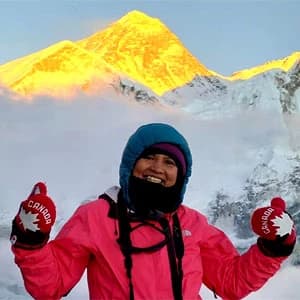
The trekking tour was guided through the Himalayan Everest Region between the 11th & 27th November 2015. The group comprises six men and one woman, all experienced...
